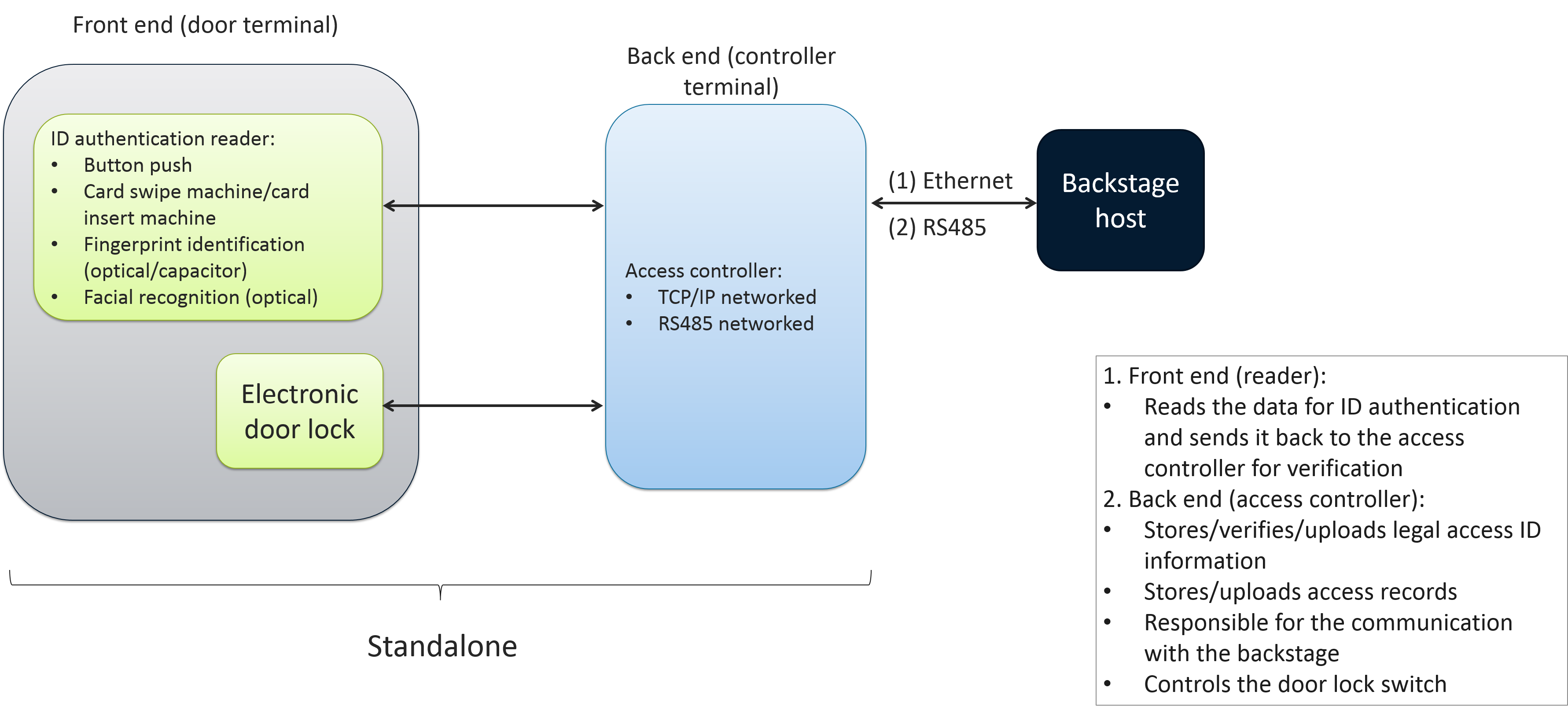The Smart Access Control System
Why is access control system needed?
As electronic products become smart, large enterprises, parking lots, elevators, and apartment occupants have increasing demand for access management; traditional door locks are no longer able to provide sufficient guarantee for safety, and smart access control systems were developed in response to this.
The architecture of access control systems includes:
1. Front end reader: Button push, RFID card reading, fingerprint identification, and facial recognition
- Reads the information of ID authentication, and sends it to the access controller for verification
2. Back end access controller: TCP/IP networked and RS485 networked
- Stores/verifies/uploads legal access ID information
- Stores/uploads access records
- Responsible for the communication with the backstage host
- Controls the door lock switch
3. Back end backstage host

Front end reader
Front end readers can be divided into the following based on different ID authentication methods:
1. Button push (uses 8bit, Cortex-M0 class microcontroller)
- 8bit: low power consumption ML51 series and N76E003 series
- Cortex-M0: NUC029, M031, low power consumption M251 series
2. RFID card reading (uses 8bit, Cortex-M0/M4 class microcontroller)
- 8bit: low power consumption ML51 series and N76E003 series
- Cortex-M0: NUC029, M031, low power consumption M251 series
- Cortex-M4: M4521 and M480 series
3. Fingerprint identification (uses ARM9, Cortex-M4 class microcontroller)
- Optical: ARM9 NUC970 series
- Capacitive: Cortex-M4 M480 series
4. Facial recognition (uses ARM9 class microcontroller)
- Arm9: NUC970 series
Back end access controller
Back end access controllers can be divided into the following based on the different communication interfaces used to connect to the backstage:
1. TCP/IP (Ethernet) networked (uses ARM9, Cortex-M4 class microcontroller)
- Arm9: NUC970 series
- Cortex-M4: M480 series
2. RS485 networked (uses Cortex-M4 class microcontroller)
- Cortex-M4: M480, M4521 and M451 series
Standalone or Split access control system?
Traditional access control systems mostly used RS485 to communicate with backstage. In recent years, almost all newly developed access control systems use Ethernet to communicate with the backstage. Generally speaking, split architecture (reader and access controller are separated; one access controller to multiple readers) is used for most of the access controls of entire buildings (manages multiple doors), whereas standalone architecture (reader and access controller are integrated into one machine) is used for most small business offices or home apartments.
Why is Nuvoton microcontroller your best choice?
1. Why is NUC970 series (ARM9 core) suitable for applying on access controllers?
- Sufficient built-in DDR memory to support system design needs (DDR size 16/32/64/128MB)
- Supports NAND/SPI interface; no limit on the plug-in Flash size
- Supports the Linux operating system
- Hardware cryptosystem engine accelerates the encryption/decryption process and reduces CPU load
- Two Ethernet ports support TCP/IP networking
- Up to 11 UART interfaces (and another 2 ISO7816 UART ports)
- Supports 2 USB HS Host ports to connect external USB storage devices
- Supports 2 SD card storage device ports
- Up to 8-ch ADC, able to detect the power status of the backup batteries and support other sensor needs
- Supports RGB interface and i80 interface, able to connect monitors
2. Why is M480 series (Cortex-M4 core) suitable for applying on access controllers?
- Up to 192MHz core speed and 512KB Flash/160KB SRAM; the sufficient memory space supports the requirements for system designing
- Supports the FreeRTOS/mbed operating system
- Ethernet 10/100 supports TCP/IP networking
- Up to 11 UART interfaces (6x LPUART + 3x ISO7816 UART + 2x USCI UART)
- Hardware cryptosystem engine accelerates the encryption/decryption process and reduces CPU load
- Supports 2 USB OTG ports (high speed and full speed) to connect external USB storage devices
- Supports 2 SD card storage device ports (up to 2x 32GB)
- Supports 5 SPI interfaces, able to plug-in SPI Flash storage
- Supports EBI interface, able to plug-in SRAM storage (up to 3x 1MB) or support i80 LCD monitors
- Up to 16-ch ADC, able to detect the power status of the backup batteries and support other sensor needs
- SPIM interface plus cache memory function supports the running of program codes on plug-in Flash